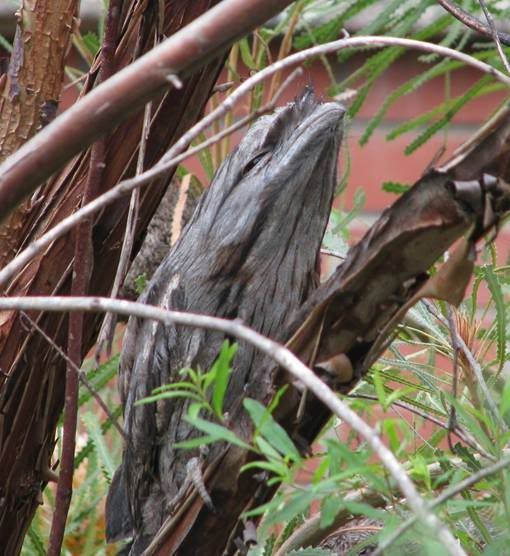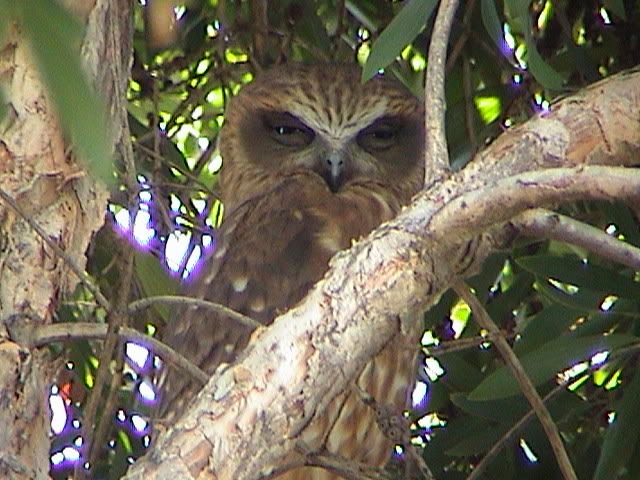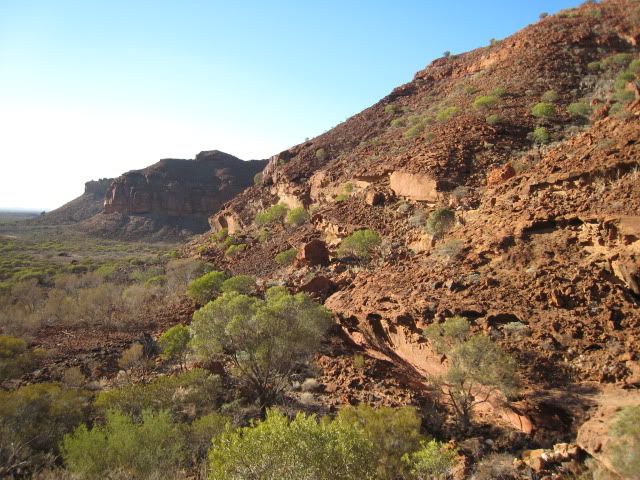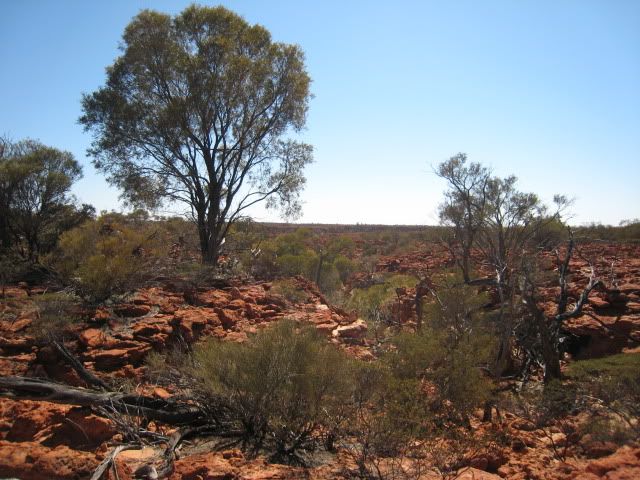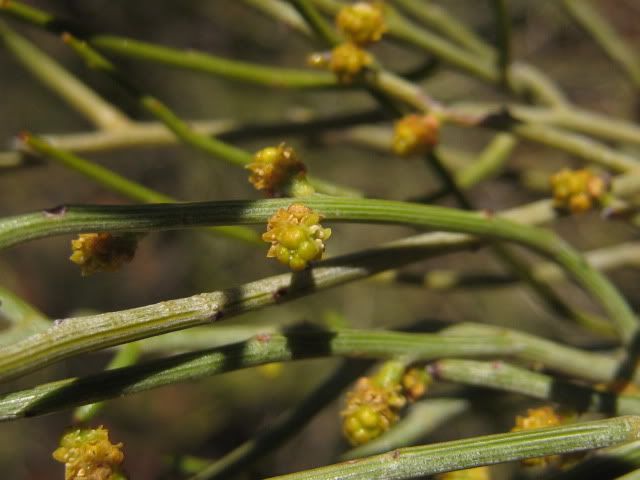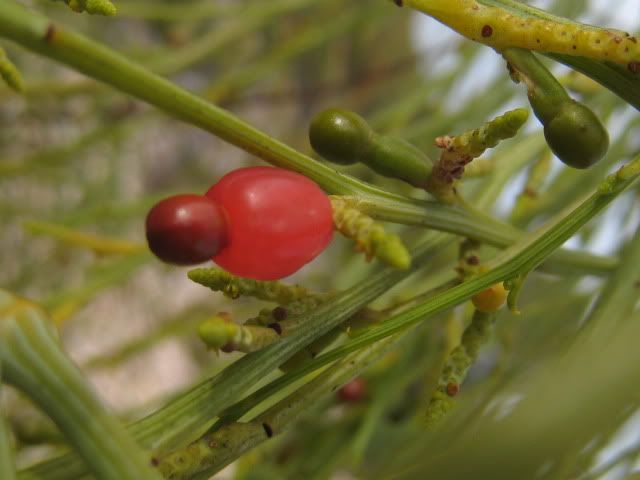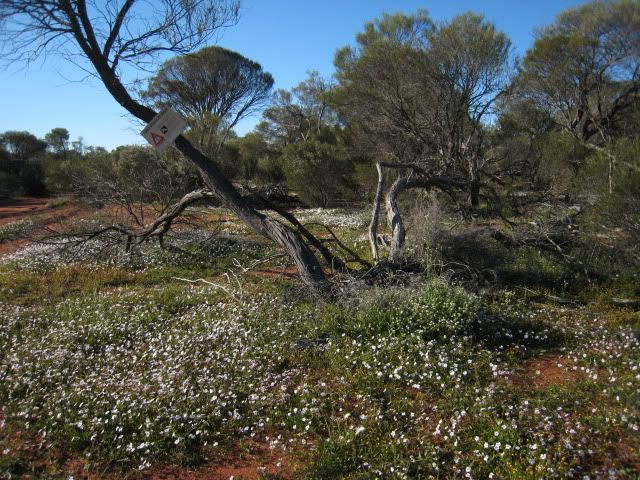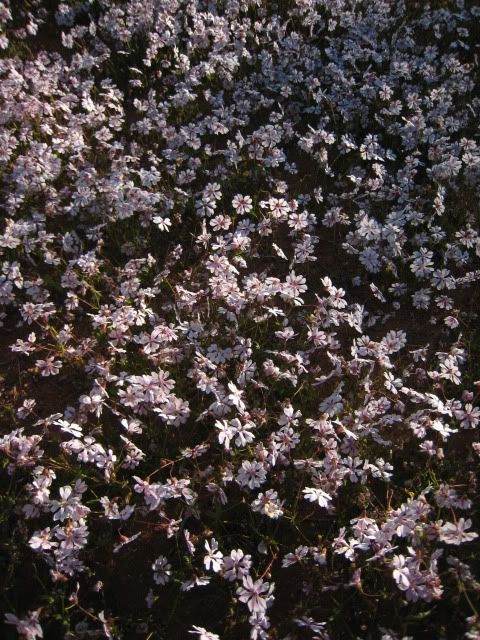Over the past week of so, a tawny frogmouth (Podargus strigoides) has been roosting in a small, mallee-form tree at my workplace.
He/she doesn't seem to notice that there is a mismatch between the grey plumage and reddish bark of Eucalyptus caesia, but hasn't deterred the frogmouth from returning each day to the same, small fork in the tree.
Other honeyeaters in the vicinity - the little browns, the New Holland and Singing honeyeaters - made a small, half-hearted effort to mob the bird, but gave up. Obviously a frogmouth doesn't get the same mob-fest attention as a boobook owl, like this owl which made the mistake to roost in our backyard and suffered days of diurnal insomnia at the hands of angry honeyeaters.
Frogmouths are funny ol' things- they're not uncommon, they're everywhere where you get decent stands of trees and scrub, but they're difficult to spot. It took 15 minutes of pointing to alert others as to the whereabouts of this particular frogmouth, despite the colour mismatch. When disturbed, they pretend to be a branch, and their superb camouflage is the key to this strategy of crypsis. It has taken five years for my kiwi partner to finally see a live frogmouth - so he has seen one in style.
Mundane observations from a height-challenged cynic about defending the smaller critters that get in the way..
Thursday, May 20, 2010
Wednesday, May 19, 2010
Omphacomeria
Omphacomeria sp. (Santalaceae)
What the .. what is Omphacomeria? I struggled with the name at first... but it goes something like" OM-FAK OH-MERIA". Like a meditative chant. It is a medium - largish shrub (1.2 - 2 m) in the sandalwood family and only has just been discovered in Western Australia growing on a remote, arid-zone range in the Gascoyne district. It is growing on a mountainous, steep, sandstone range which is popular with the tourists, and is found in steep, rocky gullies - it is growing even around the main tourist campsite.
And has been very much overlooked and required the careful eye of a taxonomist over in Canberra to confirm its identity to genus - but as yet is unidentified to species level. So, this day and this age, we're still finding new genera for the state in our remote central regions.
I don't know why it was not found beforehand - its a large shrub for starters! There have been a few floristic surveys in the region beforehand - including the CALM Carnarvon Basin survey [1], which covered the more mesic western faces of the range as part of a regional survey. And there had been mistletoe-host plant surveys and other surveys or individual collectors who tinkered at the edges of floristic knowledge for the ranges. So, in 2009, this plant turns up all of a sudden! Since we were on holiday, we popped in to have a look. This was a big ask for our tiny little Subaru imprezza - because the roads are coarsely graded and really not appropriate for small cars with no clearance (but it has AWD - yeah). But we prevailed.
It looks very much like Exocarpos aphylla and superficially like Anthobolus leptomerioides - and you'd be forgiven to jump to that conclusion, except that both species are absent from the wider region around the ranges. The lack of historical or herbarium records of an 'Exocarpos" for the range was even more puzzling - this wasn't a case of misidentification - it was a case of had not been collected before. Full stop. The photo below shows this species as locally abundant (a sparse but dominant component of shrub stratum) on the eroding slopes of the range. There - in the foreground..
It is very much a root parasite, with no leaves (just them scales), striate, photosynthetic stems and minute spikes of tiny, sessile flowers. The main clincher is the Omphacomeria is dioecious, so flowers are unisexual and there are male and female flowers on separate plants (these are male flowers - we only found dried, old fruits on female plants and I forgot to take a photo of these).
The second clincher is that the fruit has the seed INSIDE the fleshy receptacle (it is like comparing Prumnopitys versus Podocarpos, if you are so inclined). Here is broom ballart (Exocarpos sparteus) for comparison.
The third clincher for Omphacomeria is that the branches and flowers are highly resinous.
So there you have it. To date, all species of Omphacomeria occur in the eastern states of Australia, and now we have it here - in a remote, isolated mountainous range in the Gascoyne. A place well visited but not surveyed well. I think the lesson to be learnt with this new discovery is that everything deserves a second look, since it may have been overlooked at first glance. And also there is still a lot more to discover in our relatively unknown central arid-zone ranges in Australia.
[1]: Gibson N, Keighery GJ, Lyons MN (2000). The flora and vegetation of seasonal and perennial wetlands of the southern Carnarvon Basin, Western Australia. Records of the Western Australian Museum Supplement 61, pp. 175–199
What?
What the .. what is Omphacomeria? I struggled with the name at first... but it goes something like" OM-FAK OH-MERIA". Like a meditative chant. It is a medium - largish shrub (1.2 - 2 m) in the sandalwood family and only has just been discovered in Western Australia growing on a remote, arid-zone range in the Gascoyne district. It is growing on a mountainous, steep, sandstone range which is popular with the tourists, and is found in steep, rocky gullies - it is growing even around the main tourist campsite.
And has been very much overlooked and required the careful eye of a taxonomist over in Canberra to confirm its identity to genus - but as yet is unidentified to species level. So, this day and this age, we're still finding new genera for the state in our remote central regions.
I don't know why it was not found beforehand - its a large shrub for starters! There have been a few floristic surveys in the region beforehand - including the CALM Carnarvon Basin survey [1], which covered the more mesic western faces of the range as part of a regional survey. And there had been mistletoe-host plant surveys and other surveys or individual collectors who tinkered at the edges of floristic knowledge for the ranges. So, in 2009, this plant turns up all of a sudden! Since we were on holiday, we popped in to have a look. This was a big ask for our tiny little Subaru imprezza - because the roads are coarsely graded and really not appropriate for small cars with no clearance (but it has AWD - yeah). But we prevailed.
It looks very much like Exocarpos aphylla and superficially like Anthobolus leptomerioides - and you'd be forgiven to jump to that conclusion, except that both species are absent from the wider region around the ranges. The lack of historical or herbarium records of an 'Exocarpos" for the range was even more puzzling - this wasn't a case of misidentification - it was a case of had not been collected before. Full stop. The photo below shows this species as locally abundant (a sparse but dominant component of shrub stratum) on the eroding slopes of the range. There - in the foreground..
It is very much a root parasite, with no leaves (just them scales), striate, photosynthetic stems and minute spikes of tiny, sessile flowers. The main clincher is the Omphacomeria is dioecious, so flowers are unisexual and there are male and female flowers on separate plants (these are male flowers - we only found dried, old fruits on female plants and I forgot to take a photo of these).
The second clincher is that the fruit has the seed INSIDE the fleshy receptacle (it is like comparing Prumnopitys versus Podocarpos, if you are so inclined). Here is broom ballart (Exocarpos sparteus) for comparison.
The third clincher for Omphacomeria is that the branches and flowers are highly resinous.
So there you have it. To date, all species of Omphacomeria occur in the eastern states of Australia, and now we have it here - in a remote, isolated mountainous range in the Gascoyne. A place well visited but not surveyed well. I think the lesson to be learnt with this new discovery is that everything deserves a second look, since it may have been overlooked at first glance. And also there is still a lot more to discover in our relatively unknown central arid-zone ranges in Australia.
[1]: Gibson N, Keighery GJ, Lyons MN (2000). The flora and vegetation of seasonal and perennial wetlands of the southern Carnarvon Basin, Western Australia. Records of the Western Australian Museum Supplement 61, pp. 175–199
Labels:
Northwest flora,
Omphacomeria,
Santalaceae,
wildflowers
Friday, May 14, 2010
Velleia rosea
Pink velleia, Rosy velleia (Velleia rosea S.Moore).
This little herb in the Goodeniaceae family is a cheery addition to the inland, semi-arid to arid regions of midwest Western Australia. With a little winter rain, you'll find these wee, pink or lavender flushed flowers in spots and dots and fits and starts. After a decent soaking of welcome winter rainfall, this annual will form a carpet of colour that can transform a parched stand of straggely mulga (Acacia aneura) or ugly roadside rest bay (usually littered with pie-wrappers, toilet paper and beer bottles) into a little, exquisite floral wonderland.
This is one beast that I take for granted as common, but really is an endemic species of Western Australia and significant component of the winter 'desert ephemeral' flora. In flower, Velleia rosea is distinctive because of the large flowers (c. 15. - 2 cm diam., petals 1.3 cm long). But when in fruit, it can be easily confused with Velleia cycnopotamica, which has far more dainty, smaller flowers (c. 1 cm diam.) with narrow petals (corolla lobes lacking wings). Both species are sprawling little herbs, with a basal rosette of leaves and few-branched inflorence stalk with flowers arranged in cymes.
I didn't notice until it was pointed out to me by a hopeless romantic that the petals were indeed heart shaped. I just refered impassively to them as emarginate or cordate or winged, and didn't think of the flowers in any emotive way. But there ya go - they're heart-shaped and pale rose in colour, with a blush of deeper rose-magenta in the throat. I will note that descriptions of flower colour may vary with the observer, but I would hesitate to describe the colour as fuchsia and settle on rose, lilac, pale lavender or pale pink, ranging to white.
Whatever your choice of colour description, make sure you take the time out to stop for a rosy flush of Velleia rosea on a midwest winter roadtrip.
This little herb in the Goodeniaceae family is a cheery addition to the inland, semi-arid to arid regions of midwest Western Australia. With a little winter rain, you'll find these wee, pink or lavender flushed flowers in spots and dots and fits and starts. After a decent soaking of welcome winter rainfall, this annual will form a carpet of colour that can transform a parched stand of straggely mulga (Acacia aneura) or ugly roadside rest bay (usually littered with pie-wrappers, toilet paper and beer bottles) into a little, exquisite floral wonderland.
This is one beast that I take for granted as common, but really is an endemic species of Western Australia and significant component of the winter 'desert ephemeral' flora. In flower, Velleia rosea is distinctive because of the large flowers (c. 15. - 2 cm diam., petals 1.3 cm long). But when in fruit, it can be easily confused with Velleia cycnopotamica, which has far more dainty, smaller flowers (c. 1 cm diam.) with narrow petals (corolla lobes lacking wings). Both species are sprawling little herbs, with a basal rosette of leaves and few-branched inflorence stalk with flowers arranged in cymes.
I didn't notice until it was pointed out to me by a hopeless romantic that the petals were indeed heart shaped. I just refered impassively to them as emarginate or cordate or winged, and didn't think of the flowers in any emotive way. But there ya go - they're heart-shaped and pale rose in colour, with a blush of deeper rose-magenta in the throat. I will note that descriptions of flower colour may vary with the observer, but I would hesitate to describe the colour as fuchsia and settle on rose, lilac, pale lavender or pale pink, ranging to white.
Whatever your choice of colour description, make sure you take the time out to stop for a rosy flush of Velleia rosea on a midwest winter roadtrip.
Labels:
Goodeniaceae,
midwest flora,
Velleia,
wildflowers
Sunday, May 2, 2010
Lawrencia helmsii
Lawrencia helmsii (Malvaceae): Dunna dunna.
If you are travelling through the midwest regions of Western Australia, you may chance upon this chunky, straggely, cactus-like shrub that's about 1 - 1.5 m tall and just as wide.
It isn't a cactus, despite appearances, and we don't have Cactaceae native to Australia. But, it is a member of the mallow or hibiscus family (Malvaceae) and is a hardy occupant of dry, rocky gypsum and calcrete soils in the midwest regions of Western Australia. These tend to be mineral-enriched, clayey, saline, basic soils (pH abouts 8.0 ), often on or around rocky rises and saline / gypsum flats. This one we encountered was c. 70 km - 100 south of Newman, but we failed to take notice of exactly where we were along a seemingly endless stretch of the Great Northern Highway. No doubt however - we were at the extreme northern limit of its distribution.
Despite initial appearances as a chunky monstrosity, Lawrencia helmsii - the Dunna Dunna, is a intricate plant when explored up close. If you look carefully at one of the many hundreds of tiny flowers which crowd along on the stems, you see that it is close to a mallow or hibiscus flower. Well - you are hard-pressed to see much really, and you need a bit of imagination. And these flowers are about -- oh - about 5 mm in diameter. This is a flower from a male plant which I have photographed - the species is actually dieocious. There is not much to these male flowers - five tiny reddish-green petals, a staminal column with a cluster of anthers at the top. The female flowers are similar, but with more style and less dangly bits.

These flowers are emerging directly from the woody stem on a very, very short stalk (they're close to sessile, really), between the tightly packed, very short branches crowded with tight clusters of scaley leaves. Looking at the stems in detail is like a trip into an ever-shrinking world of tiny, fine features. There are about 14 species/taxa of Lawrencia in Western Australia (which is the sum total of the species in Australia), and a couple of these are equally as bizarre as L. helmsii (like L. chrysoderma). I have included informally named taxa in that count.
Lawrencia helmsii has been described as a succulent, but that's only really because the tiny, tiny leaves are sort-of succulent. I'm not convinced. The stem is certainly not - it is woody and tough and sort of spongy like balsa wood. These main stems are certainly not a source of juice or water for the thirsty in the desert.
Because these are such weird-looking plants, there is some interest in growing them as an ornamental - but they grow in such a relatively extreme habitat that I'm not sure how they would go in an ordinary garden - unless you lived on a gypsum flat.
If you are travelling through the midwest regions of Western Australia, you may chance upon this chunky, straggely, cactus-like shrub that's about 1 - 1.5 m tall and just as wide.
It isn't a cactus, despite appearances, and we don't have Cactaceae native to Australia. But, it is a member of the mallow or hibiscus family (Malvaceae) and is a hardy occupant of dry, rocky gypsum and calcrete soils in the midwest regions of Western Australia. These tend to be mineral-enriched, clayey, saline, basic soils (pH abouts 8.0 ), often on or around rocky rises and saline / gypsum flats. This one we encountered was c. 70 km - 100 south of Newman, but we failed to take notice of exactly where we were along a seemingly endless stretch of the Great Northern Highway. No doubt however - we were at the extreme northern limit of its distribution.
Despite initial appearances as a chunky monstrosity, Lawrencia helmsii - the Dunna Dunna, is a intricate plant when explored up close. If you look carefully at one of the many hundreds of tiny flowers which crowd along on the stems, you see that it is close to a mallow or hibiscus flower. Well - you are hard-pressed to see much really, and you need a bit of imagination. And these flowers are about -- oh - about 5 mm in diameter. This is a flower from a male plant which I have photographed - the species is actually dieocious. There is not much to these male flowers - five tiny reddish-green petals, a staminal column with a cluster of anthers at the top. The female flowers are similar, but with more style and less dangly bits.

These flowers are emerging directly from the woody stem on a very, very short stalk (they're close to sessile, really), between the tightly packed, very short branches crowded with tight clusters of scaley leaves. Looking at the stems in detail is like a trip into an ever-shrinking world of tiny, fine features. There are about 14 species/taxa of Lawrencia in Western Australia (which is the sum total of the species in Australia), and a couple of these are equally as bizarre as L. helmsii (like L. chrysoderma). I have included informally named taxa in that count.
Lawrencia helmsii has been described as a succulent, but that's only really because the tiny, tiny leaves are sort-of succulent. I'm not convinced. The stem is certainly not - it is woody and tough and sort of spongy like balsa wood. These main stems are certainly not a source of juice or water for the thirsty in the desert.
Because these are such weird-looking plants, there is some interest in growing them as an ornamental - but they grow in such a relatively extreme habitat that I'm not sure how they would go in an ordinary garden - unless you lived on a gypsum flat.
Labels:
Lawrencia helmsii,
Malvaceae,
midwest flora,
wildflowers
Saturday, May 1, 2010
Chthonocephalus pseudevax
Chthonocephalus - etymology: to have one's head stuck close to or in the ground. Literally meaning (in greek), "soil-head".

What a huge name for such a diminutive, unobtrusive plant. This little daisy grows in the more arid regions of Australia, on the impoverished silty clay loams which form the 'red sands' of the region. It is a spring annual (or desert ephemeral), and only really appears after good rainfall during winter months. The main thing is that it is tiny! The heads (compound capitula) are only 1 - 3 cm in diameter, the plant is little more than a compact plant with a nice tap root, a whorl of leaves and then a compact compound flower head of tiny flowers (the florets).
Until Phil Short's review in 1990, there really was only about three species of Chthonocephlus. Now there are at least seven species, all very cryptic and requiring some detailed microscope work to work out whom is who. Chthonocephlus pseudevax is the common woolly groundhead, and is differentiated from the uncommon C. oldfieldianus by having 3 or 4 lobed florets instead of 5 lobed florets.
Not that you could possibly tell from a mere glance downwards. In fact, you'd be lucky to notice these plants at all if you weren't scanning the ground with a careful eye.
So next time you are walking among the wildflowers in the right area (i.e. inland Australia on red silty clay soils) - look down for Chthonocephalus - the little plant with the ridiculously big name.
Short, Philip S. (1990). A revision of the genus Chthonocephalus Steetz. (Asteraceae : Inuleae : Gnaphaliinae). Muelleria Vol. 7:225-238. National Herbarium and Botanic Gardens. Melbourne.
Addendum - I suspect that the image on Florabase website is not C. pseudevax but C. viscosus. Given that the premises are about to move, now is not a good time to tell them that that image and its voucher needs reconsideration.

What a huge name for such a diminutive, unobtrusive plant. This little daisy grows in the more arid regions of Australia, on the impoverished silty clay loams which form the 'red sands' of the region. It is a spring annual (or desert ephemeral), and only really appears after good rainfall during winter months. The main thing is that it is tiny! The heads (compound capitula) are only 1 - 3 cm in diameter, the plant is little more than a compact plant with a nice tap root, a whorl of leaves and then a compact compound flower head of tiny flowers (the florets).
Until Phil Short's review in 1990, there really was only about three species of Chthonocephlus. Now there are at least seven species, all very cryptic and requiring some detailed microscope work to work out whom is who. Chthonocephlus pseudevax is the common woolly groundhead, and is differentiated from the uncommon C. oldfieldianus by having 3 or 4 lobed florets instead of 5 lobed florets.
Not that you could possibly tell from a mere glance downwards. In fact, you'd be lucky to notice these plants at all if you weren't scanning the ground with a careful eye.
So next time you are walking among the wildflowers in the right area (i.e. inland Australia on red silty clay soils) - look down for Chthonocephalus - the little plant with the ridiculously big name.
Short, Philip S. (1990). A revision of the genus Chthonocephalus Steetz. (Asteraceae : Inuleae : Gnaphaliinae). Muelleria Vol. 7:225-238. National Herbarium and Botanic Gardens. Melbourne.
Addendum - I suspect that the image on Florabase website is not C. pseudevax but C. viscosus. Given that the premises are about to move, now is not a good time to tell them that that image and its voucher needs reconsideration.
Labels:
Asteraceae,
Chthonocephalus,
midwest flora,
wildflowers
Subscribe to:
Posts (Atom)
